
Note the fine ironwork decorations.

This elaborate Gothic pulpit is equipped with a traditional sounding board to deflect the sound out into the congregation. It is also equipped with a microphone, which has become a much more tenacious tradition. An Episcopal church would sooner give up the Thirty-Nine Articles than the microphone. It is an interesting fact of history that no one ever heard anything until electrical amplification was invented.
Addendum: This pulpit was designed by Bertram Goodhue, the disciple of Ralph Adams Cram who was the architect of First Baptist in Oakland. It was installed in 1922.

Here are two very similar churches in the same block of Bingham Street, both from the 1850s, and both built with the sanctuary on the upper floor. In the middle 1800s, this was a common adaptation for churches in crowded neighborhoods of Pittsburgh and adjacent boroughs (Birmingham was still independent until 1872). Built on tiny lots, they needed space for Sunday-school rooms and social halls, but the sanctuary obviously needed a high ceiling or it would look and feel absurd. Thus the ground floor was left for the smaller rooms.
The church above was the Bingham United Methodist Church (built 1859), now the City Theatre. It is a generic church-shaped church with vaguely classical details, including rounded arches in the windows. The same shape could be given details in any style; the church below is the First Associated Reformed Presbyterian Church of Birmingham (built 1854), with a very similar outline, but Gothic pointed arches in the windows. The windows along the sides are simple rectangles, and old Pa Pitt suspects that the 14th Street end was Gothicized at some time in the later 1800s.


The name “First Associated Reformed Presbyterian Church of Birmingham” is too long to fit on a date stone.

Boston ivy is eagerly devouring the entrance, so it is hard to see that this arch is also pointed.
When this article appeared, Joseph Moore commented:
Are those really the main doors for the Presbyterian Church? Very plain – look more like a loading doc than the entrance to a church, even a Calvinist one. The United Methodist Church has the architectural articulation one would expect for the main doors for a church.
We replied:
The main entrance might have been on the long side on Bingham Street, where the garage door is now. On the other hand, the Gothic arch with columns on the end (and the very interesting woodwork on the doors) does suggest that someone intended it as a main entrance. On the third hand, one would expect more natural light in a main entrance, which would probably have led into a foyer with a stairway (or a pair of stairways, as in the South Side Presbyterian Church). And on the fourth hand, it is possible that windows flanking the entrance have been bricked up. Old Pa Pitt has not been able to persuade himself that the brickwork is all original, and he has not been able to persuade himself that it is not. And on the fifth hand (we might as well be an octopus by now), Father Pitt has not been inside this building; it is possible that the whole front is a stairwell, in which case the large Gothic windows would provide ample light.
This was one of the small number of articles that did not survive the transition between servers, so it had to be reconstructed and the comments copied by brute force.

Ralph Adams Cram was probably the greatest Gothic architect our country ever produced. There are three churches by Cram in Pittsburgh (and one in Greensburg), and each is a masterpiece in its way. East Liberty Presbyterian is overwhelmingly impressive. Calvary Episcopal is restrained and tasteful, a good fit for its low-church Episcopalian congregation. But Holy Rosary seems to be a product of the artist’s pure delight in his medium. It was finished in 1930, when Cram was at the peak of his creative powers.

The church is still in good shape, but it is no longer a worship site, and what can be done with a building this size? The offices of St. Charles Lwanga parish are here, but it is only a matter of time before someone decides that it would be more efficient to have an office building that is less expensive to maintain. Homewood is prospering much more than it was a few years ago, but it has a long way to go before it becomes a rich enough neighborhood to make it worth adapting this building; and any congregation looking for a church would have to have a high budget to maintain this one. (St. Charles Lwanga parish worships a few blocks away in the small and undistinguished, but much easier to maintain, Mother of Good Counsel church.)
We hope Holy Rosary will be preserved and restored, but it competes with many other churches and synagogues worthy of preservation and restoration. It is hard to find uses for a building so perfectly adapted to one specific purpose for which it is no longer wanted.

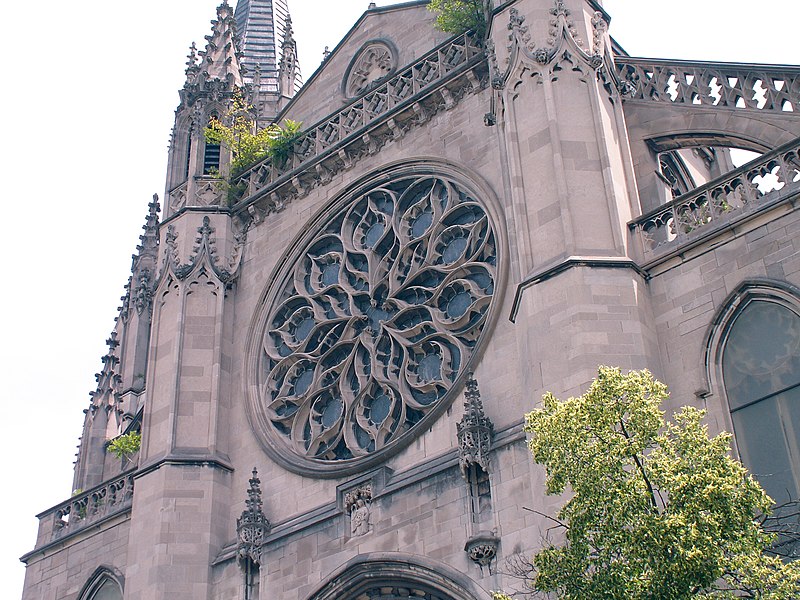
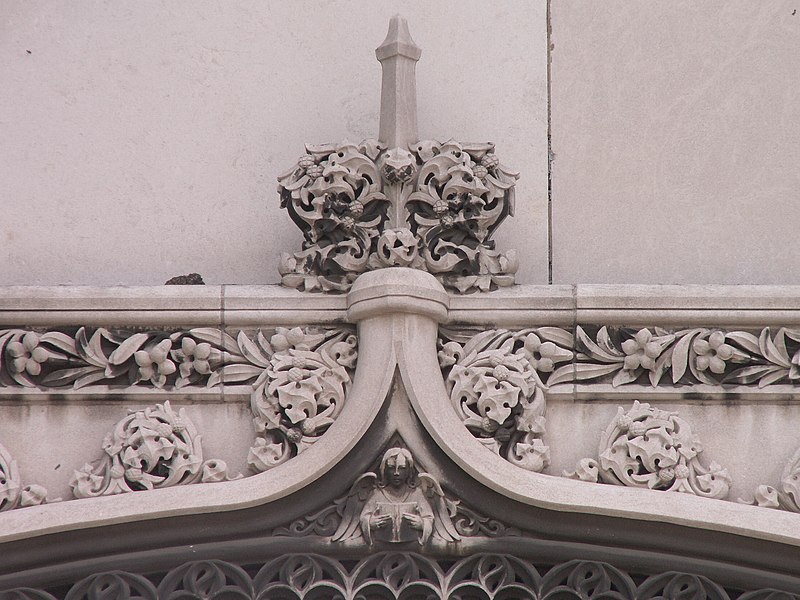


All the niches have lost their statues, which suggests that the parish took them down and reinstalled them elsewhere. Do any St. Charles Lwanga parishioners know the story? (Addendum: See the comment from Theresa Moore below; she tells us that statues were never installed.)

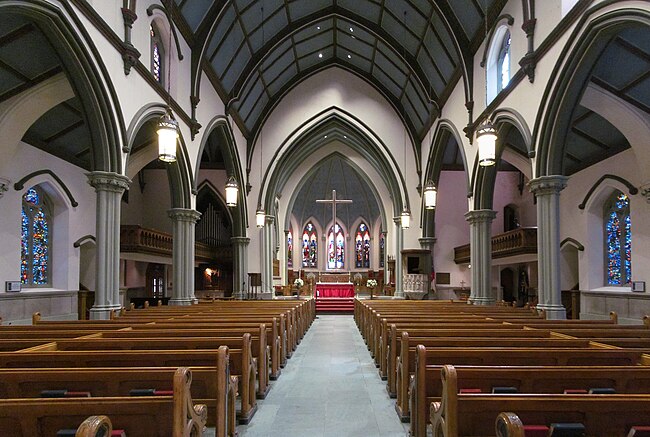
Trinity Episcopal Cathedral was built in 1872 from a design by Gordon W. Lloyd, an English-born Canadian architect who was popular among Episcopalians. The view above is made up of three pictures to give us a broad view of the nave.
This is the third church for this congregation. The first was the “Round Church,” built at about the time the streets were laid out in their present plan in 1785. (It was actually an octagon—one of the first generation of odd-shaped buildings caused by the colliding grids along Liberty Avenue.) The second was a brick Gothic church built in 1824.
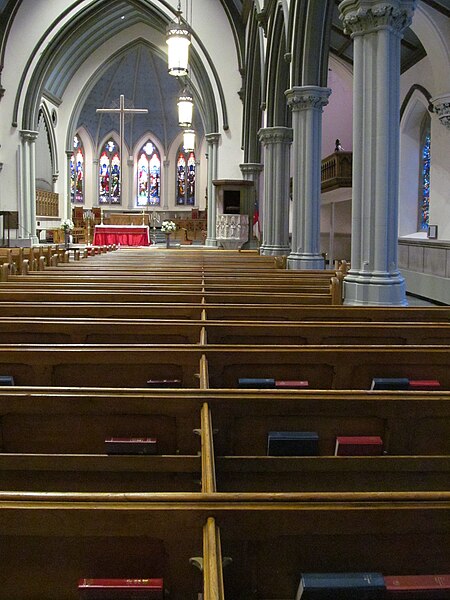
Note the divided pews, which are the original furniture from 1872. At the time this church was built, churches were generally funded by pew rents. Your family would rent a particular section, and that was where you sat every Sunday.

The number on the end of the pew identifies your section. When Father Pitt visited, the dean of the cathedral, the Very Reverend Aidan Smith, was kind enough to bring out a precious historical artifact: a pew chart of the previous church marked with the prices for each section. The closer to the front (and the more visible) the pew, the more it cost per annum. He explained that this cathedral stopped the practice of pew rents in the 1930s, after receiving a large legacy on the condition that pew rents would be stopped. (In addition to funding the church, they were a good, but arguably un-Christian, way of keeping out the undesirable poor.)



The elaborately carved reredos does its part to focus attention on the altar before it. The four wooden figures are Peter and John on the left, Paul and James the Greater on the right. The carving was done by the Irving & Casson—A. H. Davenport Co. of Boston

Henry Clay Frick really liked the Phipps Conservatory in Schenley Park when it went up in 1892. He liked it so well that he said, “I want one of those in my back yard,” and hired Alden & Harlow to design it. (You can do that when you’re a robber baron.) They gave him a miniature of Phipps Conservatory, with a central greenhouse large enough for substantial citrus trees.
These pictures were taken in March of 2000 with a Kodak Pony 135.
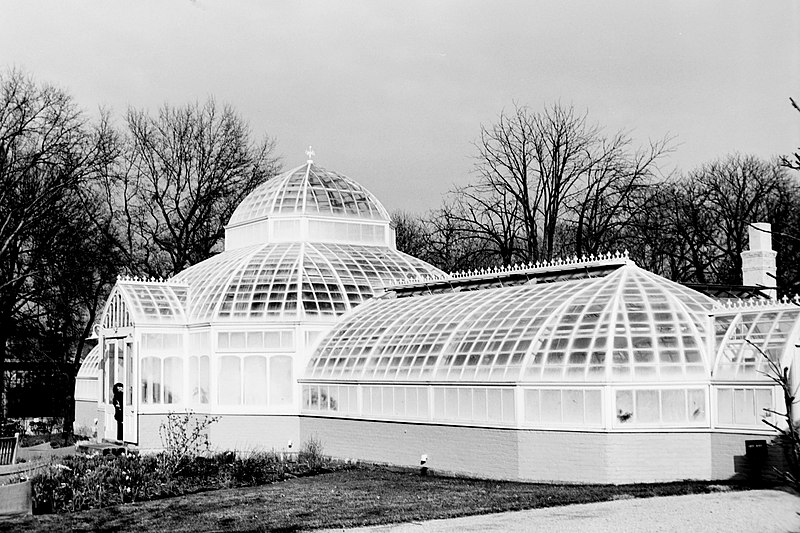
St. James Church was a Catholic parish that closed in 2004. For a while, when the West End was unsuccessfully vying with Lawrenceville to become the next artsy-trendy neighborhood, the building was an art gallery; then, in 2015, it reopened as “St. James Roman Catholic Church.” The slightly ostentatious adoption of the title “Roman Catholic” might suggest to the initiated that this is not a church in the Catholic Diocese of Pittsburgh. It belongs to a congregation of the Society of St. Pius X, the followers of Archbishop Lefebvre, who repudiate Vatican II and all its works and all its pomps.
The building was put up in 1884 for a congregation founded thirty years earlier; old Pa Pitt has not been able to determine who the architect was. (The name is not mentioned in the centennial book the congregation published in 1954.) Neighbors in the West End are delighted to have the church building well taken care of.

Built in 1884 in a Victorian Gothic style—Father Pitt calls it Commercial Gothic—this was a bank until 1943, according to the Lawrenceville expert Jim Wudarczyk. After that it was offices for quite a while, and then was refurbished as a restaurant and apartments above. This is not a great work of architecture, but the details are interesting and worth a close look. The builder reveled in his corner location and made that corner the focus of the whole building. Old Pa Pitt can’t help thinking that the treatment of the windows could have been improved by making it either more interesting or less interesting; the stone accents are either too much or too little.